
Pumas-AI – a new company established by University of Maryland School of Pharmacy faculty members Vijay Ivaturi, PhD, assistant professor in the Department of Pharmacy Practice and Science (PPS), and Joga Gobburu, PhD, MBA, professor in PPS – is proud to announce the release of its first cutting-edge software platform for pharmaceutical researchers and clinicians. Known as Pharmaceutical Modeling and Simulation (Pumas), the software was developed through a partnership with experts at Julia Computing. Research and software development efforts were led by Christopher Rackauckas, PhD, senior research analyst in PPS, with input from independent contributor Joakim Nyberg, PhD, from Uppsala, Sweden.
“The success rate for pharmaceutical innovations is approximately two percent,” says Gobburu, who also serves as executive director of the Center for Translational Medicine (CTM) at the School of Pharmacy. “Pumas software is tailored to revolutionize big data analytics in health care, unlike those tools used in other fields. By combining the extensive health care knowledge of our faculty and staff with the scientific computing experts at Julia Computing, we have developed a tool that will not only benefit business leaders working in the pharmaceutical industry, but also those who are caring for patients on the front line of health care delivery.”
Pumas is the first software platform released by Pumas-AI, whose goal is to double pharmaceutical and patient care success rates by democratizing tools and education in the health care data analytics space. The Pumas software platform provides a wide range of analytic capabilities for pharmaceutical and biotechnology development, as well as therapeutic decision making – addressing a crucial need for pharmaceutical companies and investors, who often base their decisions on a combination of technical, regulatory, and commercial success probabilities, all of which the Pumas software can provide quantitatively.
“Pumas is our company’s first product specifically designed for professionals in the pharmaceutical and health delivery sectors to bridge this gap,” adds Gobburu. “It leverages the Julia programming language, and combines modern artificial intelligence (AI) with traditional mechanistic models, allowing the CTM to foster one of its goals of enhancing real-world data (RWD) analytics through its newly formed Health Analytics Collective (HAC).”
A comprehensive platform based on the Julia programming language, Pumas contains multiple modules designed to meet the needs of analysts in the pharmaceutical industry, while also working to advance therapeutic innovation in the clinic setting. Julia was selected for its speed and succinctness as a programming language, which produces an interface that looks similar to R, but operates at the speed of FORTRAN. Because Pumas is created entirely in Julia, users can make direct use of the language’s database, statistics, and visualization functionality – all without losing performance.
In addition, Julia is the programming language of choice for prominent researchers at institutions such as the Massachusetts Institute of Technology (MIT) who work on projects at the cutting-edge of machine learning, as well as in differential equations research, which means that, unlike many other tools, Pumas has the unique ability to directly incorporate modern techniques to achieve maximal efficiency and accuracy.
“Pumas is the first pharmaceutical modeling suite that is designed from the ground up to use modern graphics processing unit (GPU) hardware, parallelized stiff differential equation solvers, and allow for the integration of machine learning with pharmacometrics,” says Rackauckas. “We are excited to not only accelerate current workflows, but also help users explore the new, realistic models that are enabled by this technology.”
Sign up for the free insideBIGDATA newsletter.




Speak Your Mind